This post may contain affiliate links, which means I get a small percentage of the sale at no extra cost to you. I only recommend items I love and have had a positive experience with. Thank you!
Enjoy the deliciously sweet and nutty flavor of pure almond extract in your kitchen creations. Almond extract is super easy and inexpensive to make. It makes a great gift too!
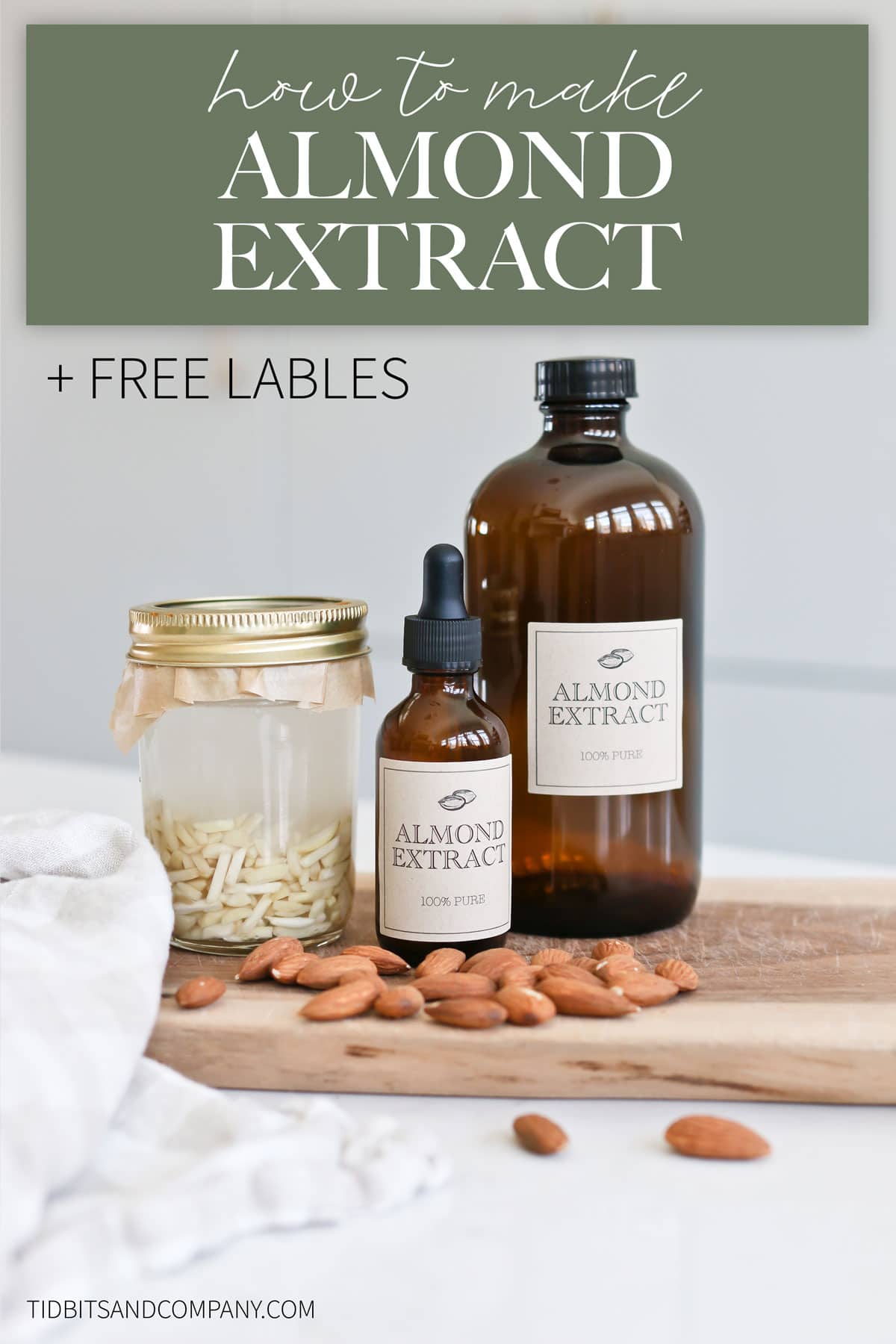
It’s getting to be the season of sweets and treats. It’s time to start thinking about baking up holiday goodies for friends and family. I love this time of year!
I know I’ll certainly be reaching for my stash of homemade extracts. Recently, I showed you how I make homemade vanilla extract, homemade orange extract, homemade mint extract and homemade lavender extract.
Today, it’s almond extract. One of my absolute favorite food flavorings! I think almond extract always adds a touch of something really special to desserts and baked goods.
If you’ve ever wondered how to make your own pure almond extract, you’re in luck. I’m going to show you how easy it is to make at home. This in one you’ll definitely want to try!
Homemade Almond Extract
Almond extract is very versatile. Although it’s not called for as often as vanilla extract, almond extract can still be used in many dishes.
Sweet foods like cookies, cakes and muffins often call for almond extract. Savory dishes like rice, quinoa and almond crusted fish can also benefit from the sweet, nutty flavor of almond extract.
It’s making me hungry just thinking about all the yummy ways to use this extract!
Homemade almond extract also couldn’t be simpler to make. It’s made by soaking raw, unroasted, unsalted slivered almonds in a high proof alcohol to extract the flavor and aroma of the almonds. No artificial colors, flavors or chemical additions. It’s 100% pure and flavorful.
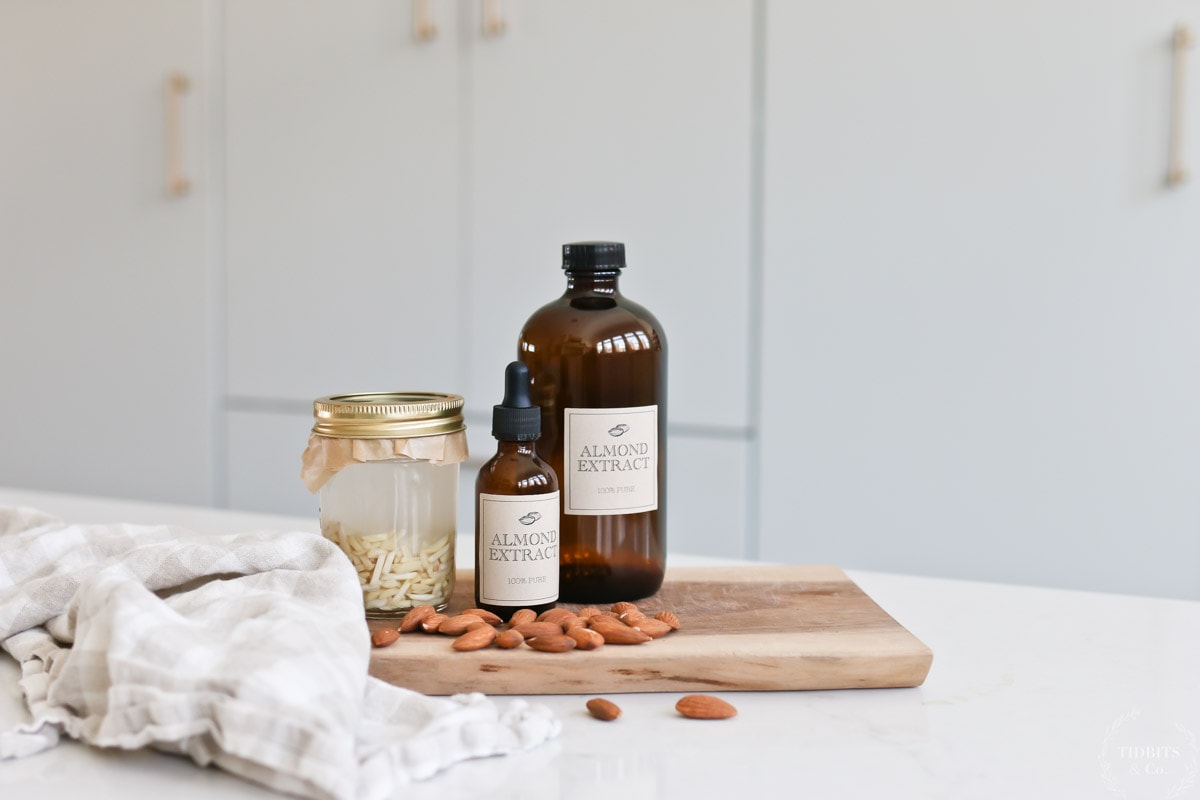
Table of contents
- Homemade Almond Extract
- Why You’ll Love Homemade Almond Extract
- What You’ll Need to Make Almond Extract
- Step-by-Step Instructions
- Storing Your Almond Extract
- Free Printable Labels
- Almond Extract Variations
- Ideas for Using Almond Extract
- Almond Extract Substitutes
- Alcohol Free Almond Extract
- Cost Analysis – Is it Worth it?
- FAQ’s
- Try These Other Extract and Herbs Recipes
Why You’ll Love Homemade Almond Extract
I think you’re really going to love making your own almond extract! Here are just some of the things that make homemade almond extract so great:
- Easy to make – You can craft a batch of homemade almond extract with almost no prep time and only 2 ingredients. It doesn’t get much easier than that!
- Cost effective – This extract can be make at a fraction of the cost of store-bought almond extract. I was amazed at the difference in cost between these two! Keep reading below to see my cost comparison for homemade vs. store-bought almond extract.
- Customizable – You can control the strength of your almond extract by adding more or less almonds to your extraction.
- Variable – Try combining your almond extract with other complimentary extracts for unique flavor combinations. You can even add extra ingredients like cinnamon to your extraction for a custom flavor profile.
- Contains to extra additives – No surprises, you control the ingredients and know exactly what you’re getting.
- Great for gifting – Homemade almond extract makes a perfect holiday gift. Don’t forget to take advantage of the free printable labels I’ve included below!
- Tastes amazing – Store-bought extracts just can’t compare to homemade.
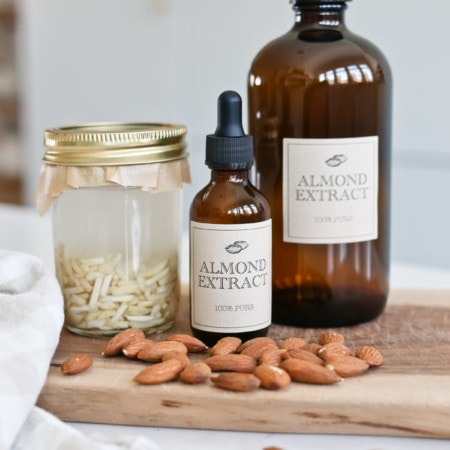
Homemade Almond Extract
Equipment
- glass jar and lid
- parchment paper
- Label with product name, start and end date
Ingredients
- raw, unroasted, unsalted slivered almonds
- Vodka or other high proof alcohol
Instructions
- Gather your almonds, clean jar and lid, parchment paper and a label.
- To your clean jar, add your almonds. You'll be looking to fill the jar 1/3-1/2 full of almonds, depending on how strong you want your extract to be.
- Fill your jar up most of the way with the alcohol. Leave a bit of head space at the top of the jar.
- Place a piece of parchment paper between the jar and lid to prevent possible corrosion from the alcohol touching the metal lid.
- Seal the jar closed.
- Label the jar with the product name, start and end date.
- Place the jar of almond extract in a cool, dark place and allow it to extract for 6-8 weeks.
- Every few days, give your jar of extract a shake to help aid the extraction process.
- When the extraction time is up, check you extract. If you feel like it needs to be stronger, simply give it a little more time until you're satisfied with the finished product.
- If desired, transfer your extract to smaller bottles that are convenient for use.
- Keep your extract stored in a cool, dark place away from direct sunlight.
- Enjoy!

What You’ll Need to Make Almond Extract
Ingredients
Making homemade almond extract is very simple. For the recipe, you will need the following ingredients:
- Almonds – Look for raw, unroasted, unsalted slivered almonds with no skins on them. Be sure to use organic almonds when you’re making extract. You don’t want to be extracting preservatives, pesticides or herbicides.
- High proof alcohol – I like to use Smirnoff 80 proof vodka for all my extracts. Other good choices include brandy, rum or bourbon.
Some people use the pits from cherries, peaches or apricots to make an almond-flavored extract because they have similar flavors. Those stone fruit pits contain a small amount of toxicity. Although it’s not much toxicity, I still prefer to use actual almonds for the best flavor and personal peace of mind.
Equipment
You’ll also need the following equipment:
- Clean glass jars with lids – I like to use mason jars for the extraction process.
- Parchment paper – to prevent possible corrosion from the alcohol touching the metal lid.
- A label with your extraction name, start and end date.
- Smaller bottles – optional, for storing your finished extract.
- A funnel – optional, but makes transferring your finished extract to smaller bottles much easier.
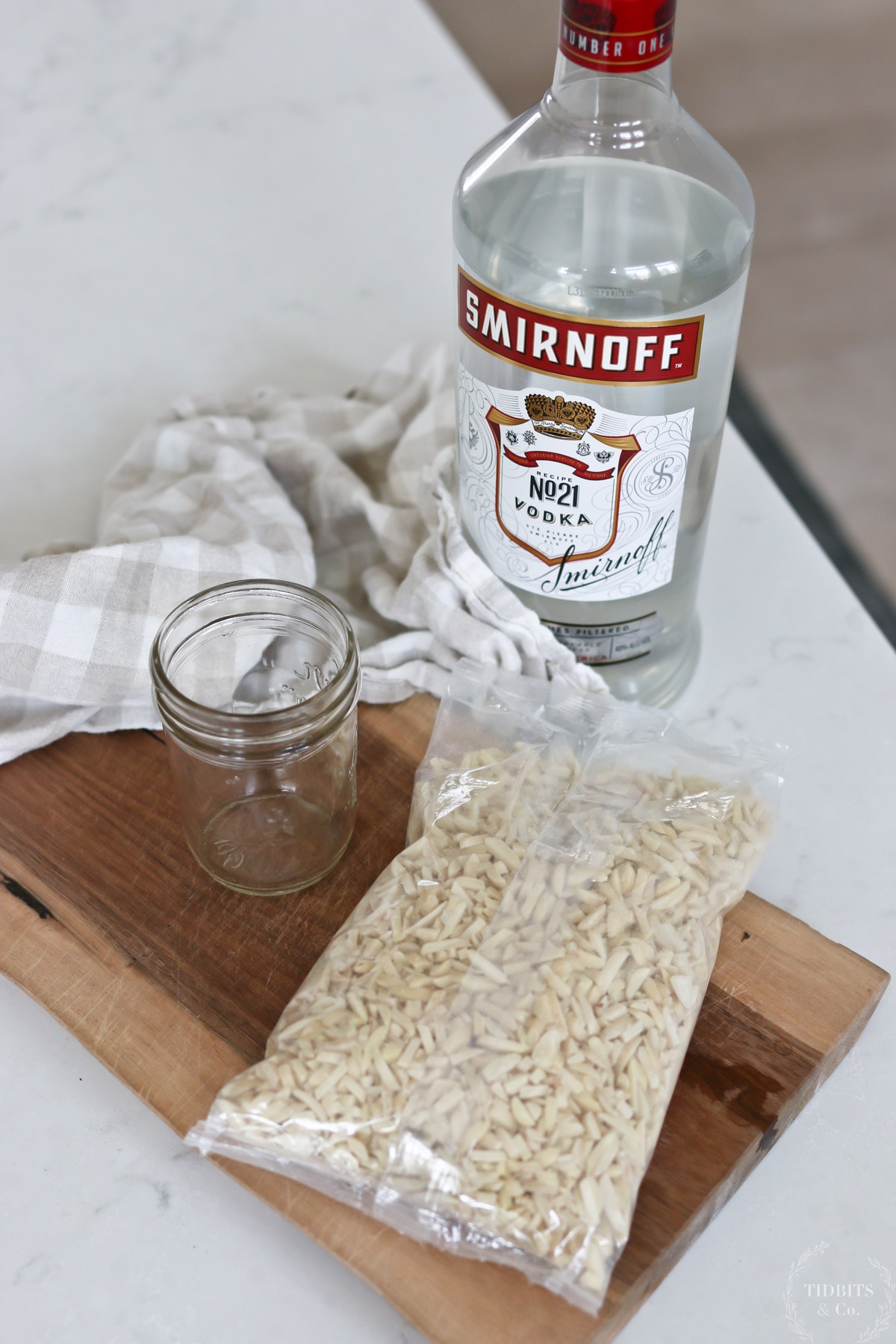
Step-by-Step Instructions
- Gather your almonds, clean jar and lid, parchment paper and a label.
- To your clean jar, add your almonds. You’ll be looking to fill the jar 1/3-1/2 full of almonds, depending on how strong you want your extract to be.
- Pour in your vodka or your alcohol of choice. Fill your jar up most of the way with the alcohol. Leave a bit of head space at the top of the jar.
- Place a piece of parchment paper between the jar and lid to prevent possible corrosion from the alcohol touching the metal lid.
- Seal the jar closed.
- Label the jar with the product name, start and end date.
- Place the jar of almond extract in a cool, dark place and allow it to extract for 6-8 weeks.
- Every few days, give your jar of extract a shake to help aid the extraction process.
- When the extraction time is up, check you extract. If you feel like it needs to be stronger, simply give it a little more time until you’re satisfied with the finished product.
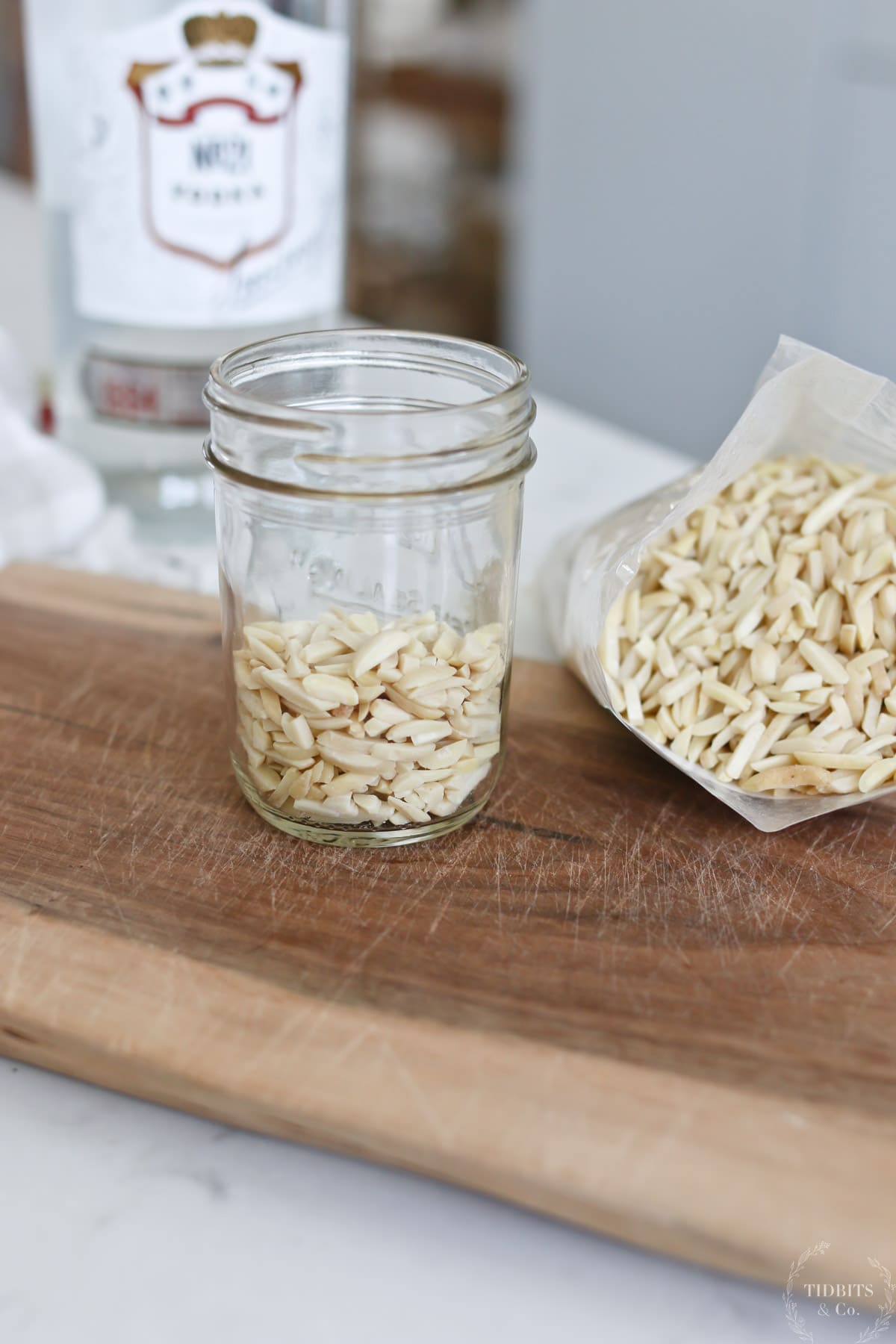
Storing Your Almond Extract
Too much light exposure can lead to a loss of extract flavor and potency. Because of this, it’s best to store your homemade almond extract in a dark container away from direct sunlight. If your extract is stored in a cool dark place away from direct sun light, it should last for several years.
When I have a lot of homemade almond extract on hand, I like to keep it in these 16 oz amber glass bottles. I also like to use these smaller 2 oz amber glass dropper bottles for extract. And these cute 1 oz amber glass dropper bottles are the are the perfect size for gifts.
Free Printable Labels
A bottle of your homemade almond extract would make a perfect Christmas gift! I have adorable printable label designs that you can download for free and size to fit whatever bottle you are using.
How to Download the Free Almond Extract Labels
Just fill out the form below, and you will get instant access to my subscriber library where I have all my free printables and downloads.
*Already a subscriber? No need to fill out the form again. The link and passcode is in each email I send.
Printing Your Label
You can print these labels at home on your own craft paper sticker labels. If you’re doing this, you’ll need blank labels like these Avery 2×2 craft paper sticker labels. You can also send these labels to a shop for printing, or have Avery print them for you.
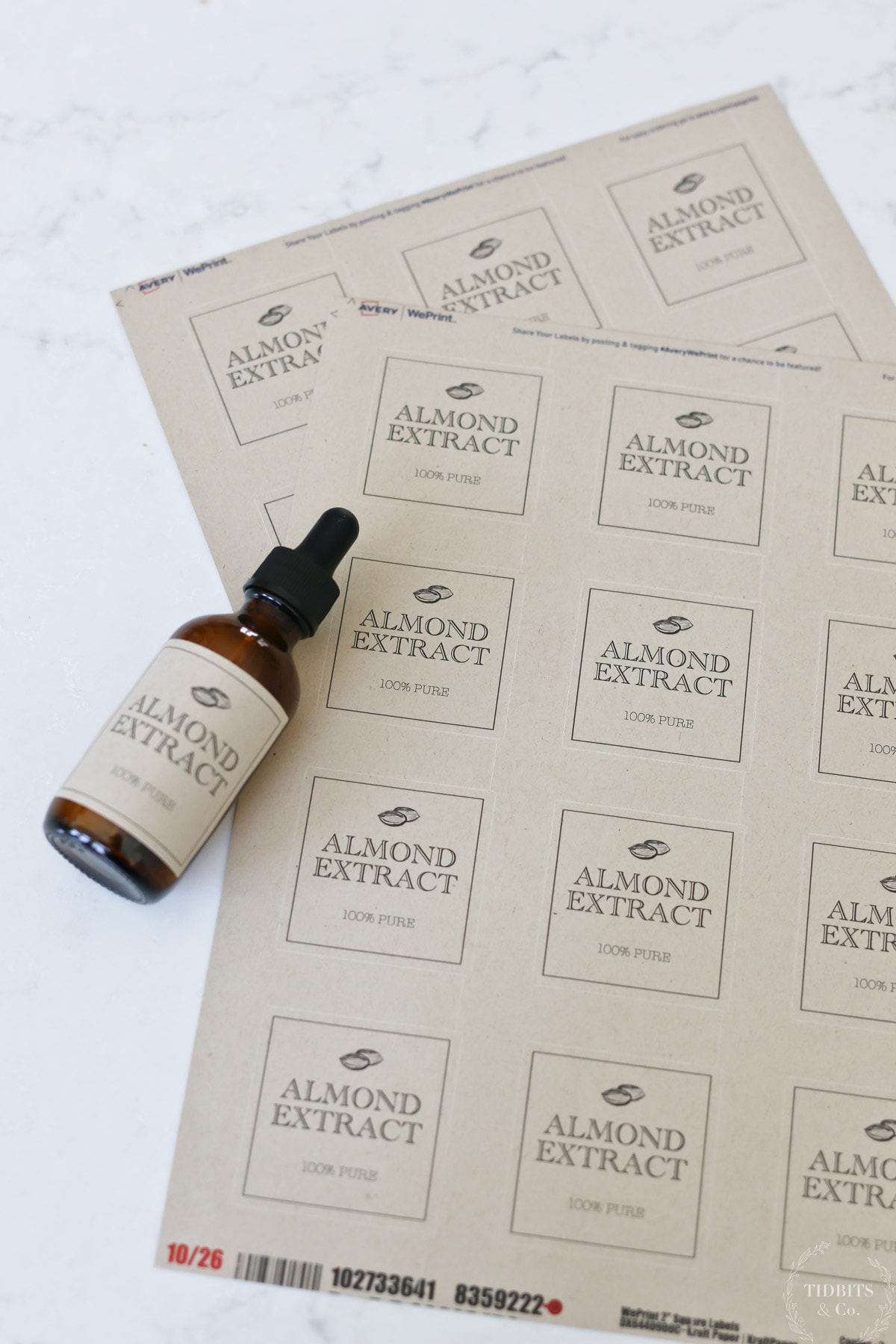
I prefer to send them out to Avery to print, since it can be difficult to get the label lined up perfectly with my printer sometimes. This way I can also order exactly what I need instead of buying a big pack of labels.
If you’re going to Avery.com print the labels for you, you’ll set up a free account, then you can upload my label design. Once onto the Avery website, you can adjust the size of the design to fit whatever label you are using for your extract bottles. Super easy and super cute!
Click over to see my How to Print and Design with Avery Labels for more details.
Almond Extract Variations
If you want to get creative, you can experiment with different almond extract variations. You can make these variations one of two ways – either combine existing extracts to make a mixed flavor extract – think something like almond and vanilla. Or, you can actually add other ingredients to your almonds as they extract. Some examples might be orange peels, cinnamon sticks or vanilla beans.
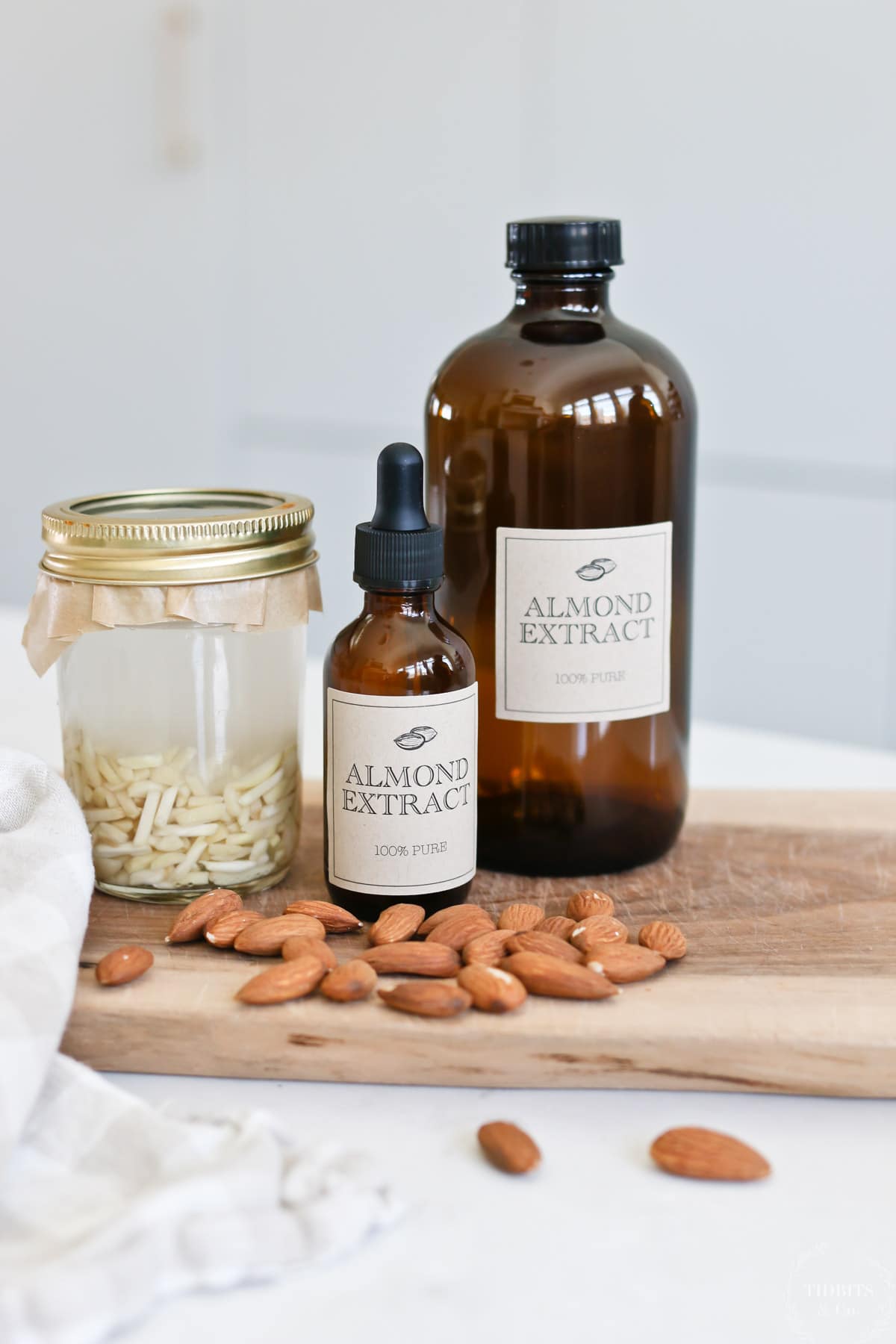
Ideas for Using Almond Extract
Now that you know how to make almond extract, it’s time to start using it!
Of course, everyone loves sweet treats. Chocolate and almond are a classic flavor combination. You could add some almond extract to your smoothies, custards, ice creams or puddings for a sweet, nutty flavor twist.
Let’s not forget sugar cookies, syrups and whipped cream. Dessert recipes are a perfect way to use your almond extract!
If you’re looking for something more savory, try adding some almond extract to your next marinade. It would be especially good in a recipe like almond crusted fish that is already using almonds. Likewise, it might be a nice accent to add to vinaigrette salad dressing, especially if you use some almonds as a salad topping. Yum!
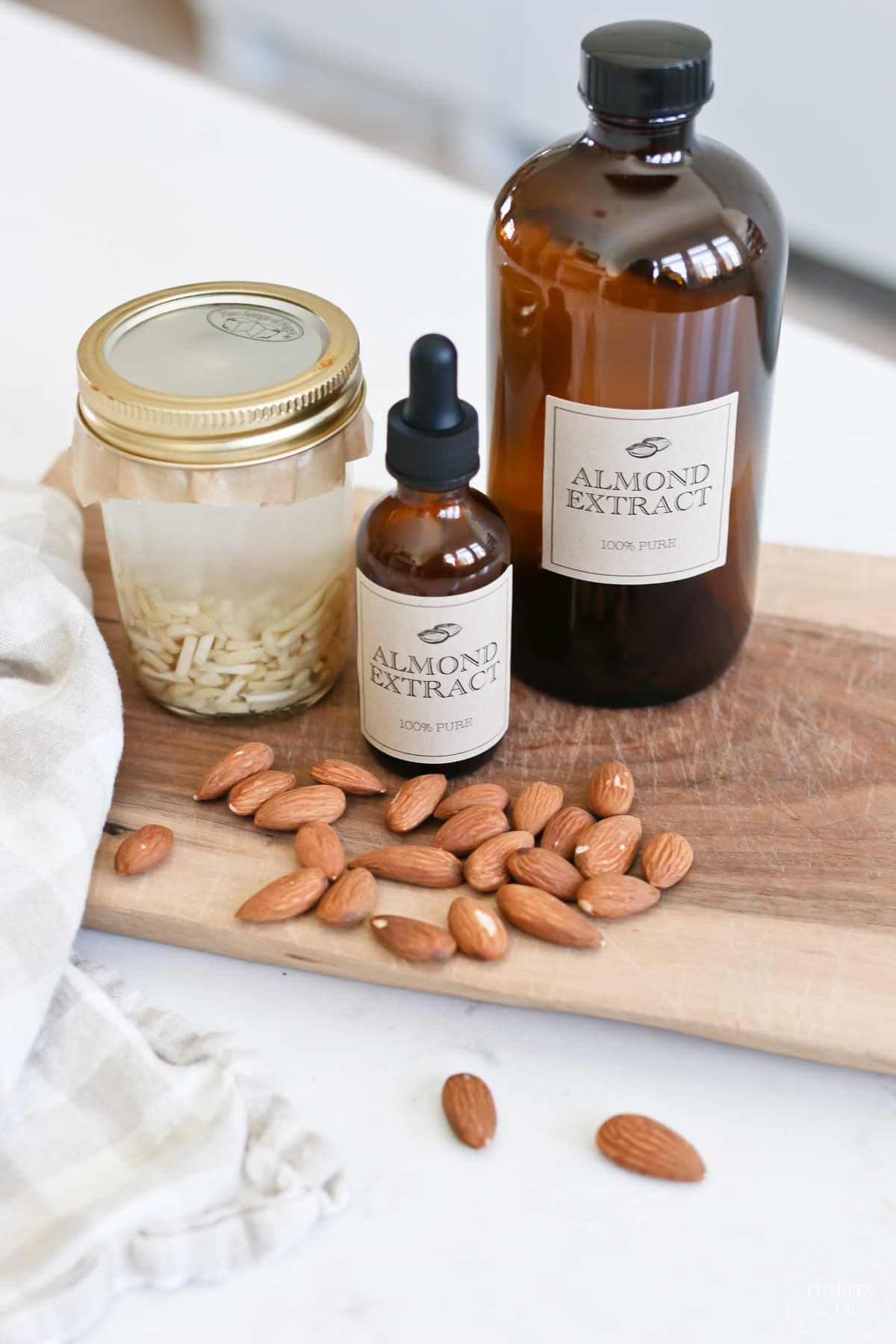
If you need a recipe to get you started, try adding a dash of almond extract to one of these:
- Use What You Got Granola
- Braided Sugar Cookies Sticks
- 5 Ingredient No Bake Healthy Coconut Bars
- All Natural Orange Almond Cookies
Almond Extract Substitutes
There are a lot of different almond flavoring food products on the market today. If you read through enough recipes, you’ll likely come across some calling for almond oil, almond extract, almond paste, almond flavor and so on.
What do they all mean? Let’s take a look at the differences so that you an decide when and how to substitute almond extract for these other products.
Common Almond Flavoring Products
- Almond Oil: Almond oil is slightly sweet and nutty tasting oil made from pressed almonds. It’s usually used as an oil for cooking, sauteing, as a topping or in salad dressings. It has a mild flavor.
- Almond Extract: Almond extract has a highly concentrated flavor. It’s made by extracting almond oils and other flavor compounds from almonds into an alcohol solution. It’s used to flavor foods, similar to how you would use vanilla extract.
- Almond Flavor: Almond flavor, almond flavor oil, or artificial almond extracts are similar in intensity to almond extract. However, almond flavor can be either naturally flavored or made from synthetic flavor compounds, depending on the variety.
- Almond Paste: Almond paste is made from ground almonds and sugar and is usually used to flavor baked goods.
As you can see, there are many ways to add almond flavor to food. Almond extract can be used as a replacement for other almond products in some places, but keep in mind the flavor and consistency differences when deciding if it will work in your recipe.
Alcohol Free Almond Extract
In case you are wondering, yes, it is possible to make an alcohol-free almond extract. If the case of an alcohol-free extract, you’ll use food grade glycerin as the extracting agent.
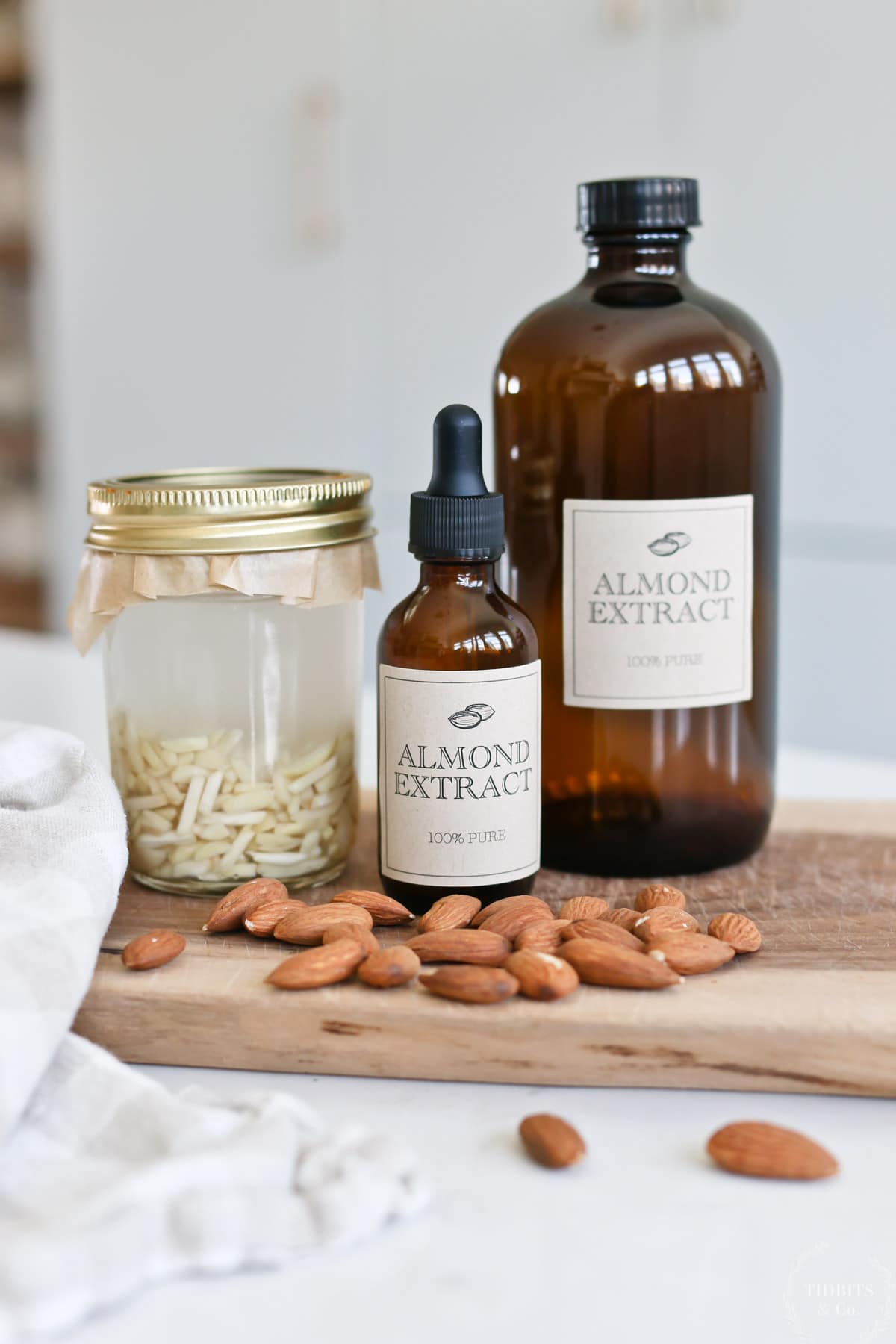
All of the measurements and instructions stay the same as the alcohol version. The extraction time will be about the same using glycerin. Expect your alcohol free almond extract to take 6-8 weeks to fully extract. Check it occasionally until you are happy with the finished product.
Your glycerin-based almond extract should have a shelf life of about 1 year.
Cost Analysis – Is it Worth it?
I’m sure some of you are wondering – is it worth it to make your own almond extract? How does the cost compare to the store-bought version? Let’s take a look! Keep in mind, prices may vary depending on what you can find and fluctuations on the market.
- 8 oz of Vodka: $5.oo
- Raw, slivered almonds (about 1/2 cup): $1.22
Total cost of pure homemade almond extract: $6.22 per 8 oz.
Cost of store-bought almond extract: $4.82 for 2 oz of McCormick Pure Almond Extract.
That equals $19.28 for 8 oz of store-bought extract compared to $6.22 for 8 oz of homemade almond extract!
I was amazed by these number! That is a huge price difference. Clearly, pure homemade almond extract is the cost winner here!
FAQ’s
Nope. If you store your almond extract in a cool, dark location, it won’t need refrigeration and should have a long shelf life.
If stored properly, alcohol based homemade almond extract should be good for several years. Glycerin based almond extract should be good for about one year.
Yes, almond is a good stand-in for vanilla but the two have different flavors. Almond extract is sweet, but also nutty tasting. Almond extract also tends to be stronger, so you may want to use less of it than you would vanilla extract. Try 1/2 teaspoon almond extract for each teaspoon of vanilla.
Almonds can trigger an allergic reaction in people with a tree nut allergy. If you have a tree nut allergy, please avoid eating almond extract.
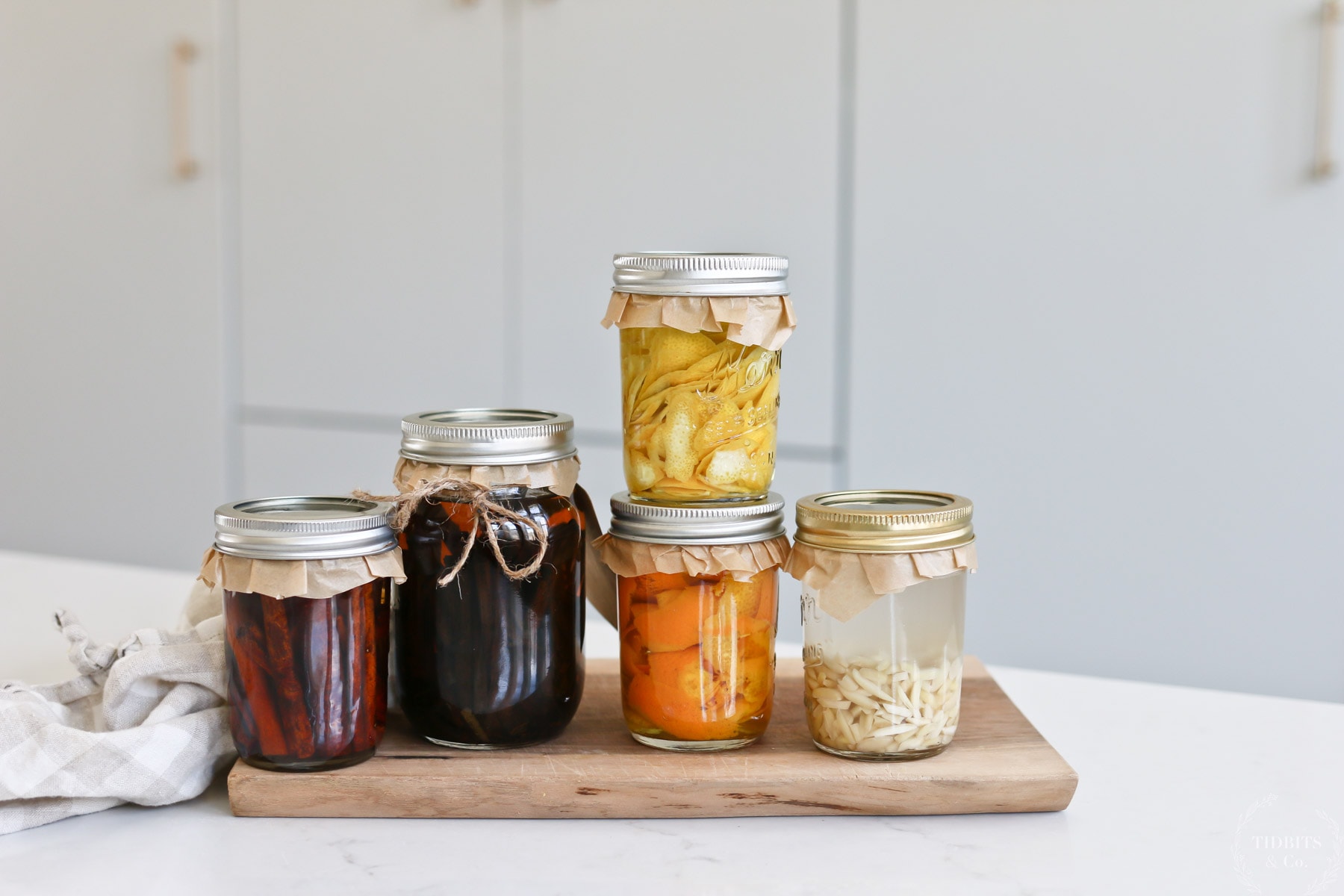
Try These Other Extract and Herbs Recipes
Homemade extracts are one of my favorite things to make. They are so easy and taste so great! I hope you’ll give this pure homemade almond extract a try. If you want to try making some extracts or similar recipes, then check out one of these to get started:
- How to Make Lavender Extract and Tinctures
- How to Make Mint Extract + Free Printable Labels
- How to Make the Best Homemade Vanilla Extract + Free Labels
- Pressure Cooker Pure Vanilla Extract
- Pressure Cooker Infused Honey
- Make Your Own Chive Blossom Vinegar
- Home to Make Orange Extract + Free Labels
- How to Make Cinnamon Extract + Free Labels
- How to Make Lemon Extract + Free Labels


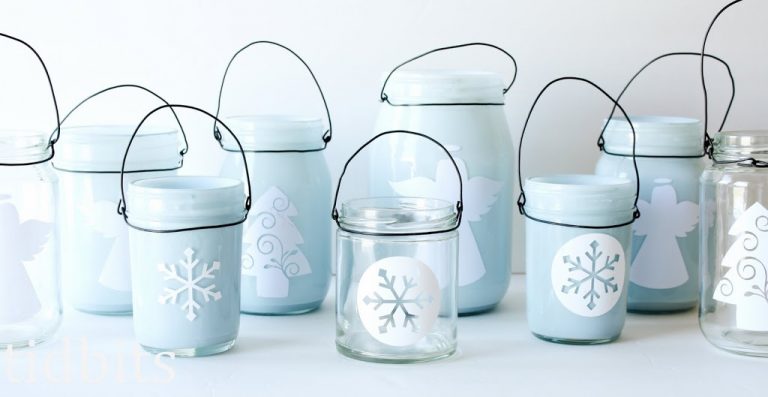
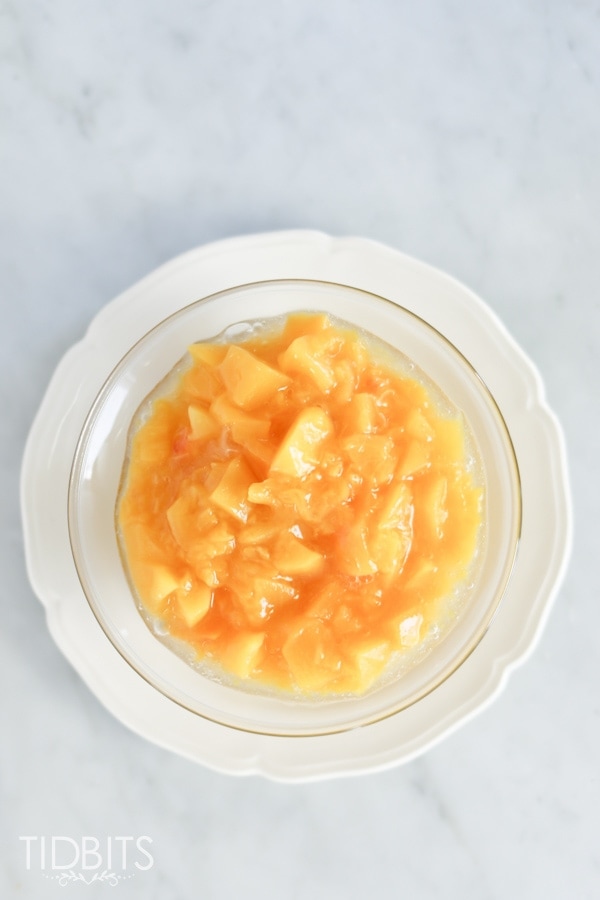
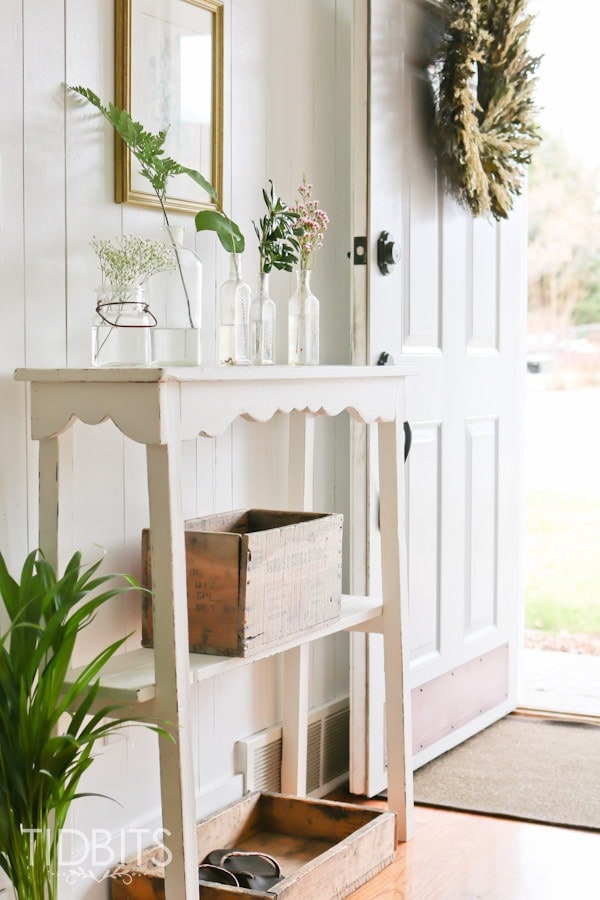
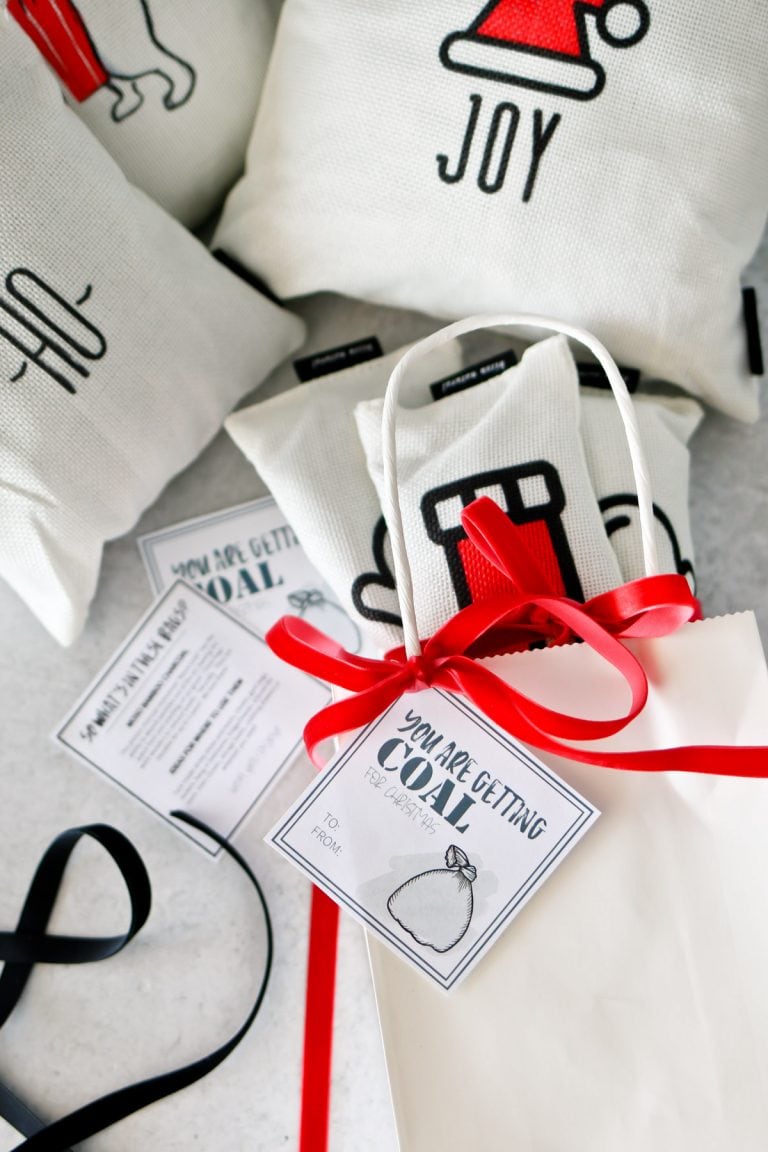







Free Printables!
Get instant access to the TIDBITS subscriber library full of free printables for the keeper of the home.
Discover more TIDBITS
Love this article? Make sure to connect with me on your favorite social platform below, and leave a comment so we can chat!